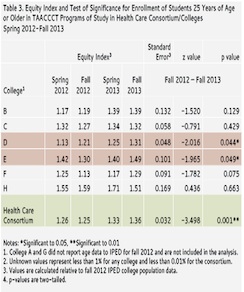There is a long standing ideology in the United States that argues that a core role of community colleges is to expand educational opportunity and create a more equitable society. This is sometimes referred to as the democratic mission[1] of community colleges. As colleges are held to higher standards for student outcomes, there is a danger that they will move away from the idea of open access to favor students with a high probability of completion[2]. To build an equitable educational system, community colleges need to work with policy makers and funders (both public and private) to engage and support underserved populations to access, progress in, and complete their postsecondary studies.
The Trade Adjustment Assistance Community College and Career Training (TAACCCT) grant program provides the basis to examine whether federal policy is contributing to the democratic mission of community colleges. I led a study at the Office of Community College Research and Leadership (OCCRL) to explore this issue using data from a TAACCCT-funded consortium that is implementing programs of study associated with health care. The consortium consists of nine community colleges in seven states that have committed to building health care pathways for students. The “Health Care Consortium” is funded through a TAACCCT grant of over $19 million.
The "Examining Equitable Representation in Programs of Study" brief analyzes the enrollment of African American, male, and non-traditional aged students in the Health Care Consortiums’ grant impacted programs. This study shows that colleges affiliated with the Health Care Consortium reported higher proportions of African American students and older students in their TAACCCT-impacted programs of study than would be expected based on their proportion in the overall college student population. Though small scale and preliminary, these findings suggest that the programs associated with federal TAACCCT investment provide greater access to college for underserved student groups than the total programs of study enrollment of these colleges.
Comparisons in this study were made to the proportion of students of the same demographic in the colleges’ total student population. The use of a reference population, in this case the same demographic in the total college student population, ensures that the findings are relevant to the student group as well as the college. This comparison is also advantageous because it relies on IPEDS data, which are readily available. However, a more nuanced analysis that involves comparing student groups in similar programs of study may be more useful to determining equitable representation in college access and completion, and these analyses will be conducted by OCCRL in the future.
How important is equitable access for underserved student populations to you and your colleagues? What do you know about access and completion to programs of study for underserved student populations? How could you use the methods demonstrated in this brief to measure equitable access and completion for underserved populations in your institution?
Heather L. Fox is a doctoral student in Human Resource Education at the University of Illinois at Urbana-Champaign and currently serves as project coordinator for the Pathways Resource Center and OCCRL.
[1] Dowd, A. (2003). From access to outcome equity: Revitalizing the democratic mission of the community college. Annals of the American Academy of Political and Social Science, 586, 92-119.
[2] Bragg, D., & Durham, B. (2012). Perspectives on access and equity in the era of (community) college completion. Community College Review, 40(2).
